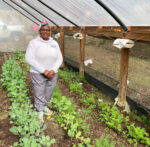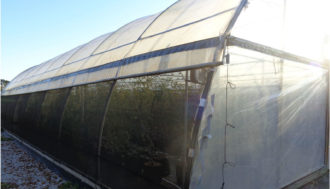In the organic farming model, pests (insects, weeds, and pathogens) are known as the yield-limiting factors that must be managed. Uncontrolled levels of pests result in over 50 percent crop loss. High tunnels not only extend the production season for the producer, but they also extend the life cycle of insect pests that may linger on longer compared to open field. Crop damage from insect pests can occur via direct feeding or egg-laying, contamination with feces, or disease transmission; loss in yield or marketability of vegetables in the absence of Integrated Pest Management (IPM) can be nearly 100 percent.
Organic IPM practice consists of a three-tiered approach consisting of systems-based practices, mechanical tactics, and biorational insecticides. Mechanical tactics encourage the use of physical barriers for pest exclusion. Some popular pest exclusion tactics include the use of floating row covers for protection against flying insects, bagging fruits, and installing metallic collars around transplants to protect them from cutworms and armyworms. In all these cases, a barrier is created between the insect pest and the host plant for short-term protection.
Alabama Cooperative Extension has developed a series of bulletins that highlight research data and field observations about the success of shade cloths as a more permanent barrier system around the high tunnels. These high tunnel pest exclusion (HTPE) systems are one of the best relatively low-cost pest preventive practices available to producers in the Southeast.
The goal of this system is to PREVENT insect pest establishment and reduce the overall pest pressure. The goal is NOT to exclude ALL pests or beneficial insects. In other words, an ideal HTPE system should have a good balance of stopping pest species while allowing beneficial insects to colonize the plants.
High Tunnel Pest Exclusion System
Insect pests are one of the major problems in organic production systems. Organic IPM practice consists of a three-tiered approach consisting of systems-based practices, mechanical tactics, and biorational insecticides. Mechanical tactics encourage the use of physical barriers for pest exclusion. This bulletin provides preliminary research data and field observations about the success of shade cloths, or high tunnel pest exclusion (HTPE) systems, as a more permanent barrier system around the high tunnels.
High Tunnel Pest Exclusion System Part II
With the increasing demand for local foods across the Southeast, an increasing number of beginning, as well as experienced producers are producing vegetable crops in high tunnels for direct and whole sale markets. From the insect management perspective, it is extremely critical to adopt pest prevention practices; the high tunnel pest exclusion (HTPE) system is one of the best relatively-low cost pest preventive practices available to producers in the Southeast. This HTPE technology uses a variety of shade cloths for a relatively permanent pest prevention strategy. This bulletin provides information on the use of HTPE systems on the farm.

Pest Exclusion Systems for Pest Management in Vegetable Production Across the Southeast
In organic vegetable production, and in situations where farmers are seeking to reduce chemical applications, Integrated Pest Management (IPM) strategies are recommended to exclude pests in both opens fields and in high tunnels. The principles of pest exclusion involve separating the insect pest from the host plant and protecting the crop at a specific growth stage. Careful planning of both materials selected and management design are important to keeping pests out of a cash crop. This bulletin provides data and information from on-farm demonstrations on the use of pest exclusion systems. Pest exclusion systems use shade cloths as a barrier around high tunnels, low tunnels and hoop houses to exclude insect pests.


